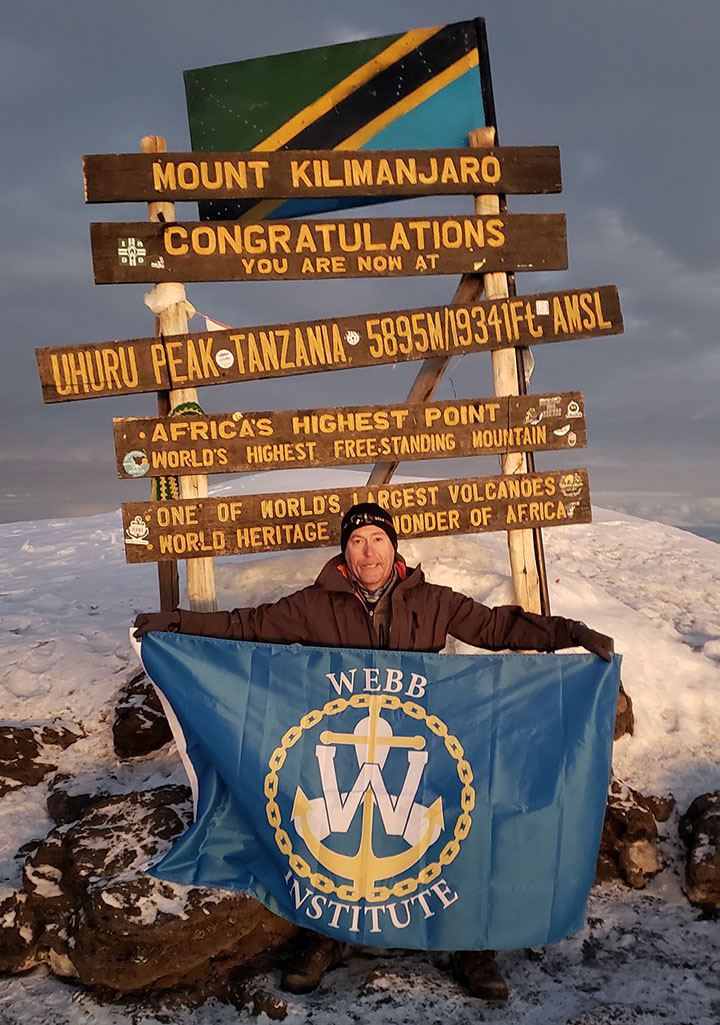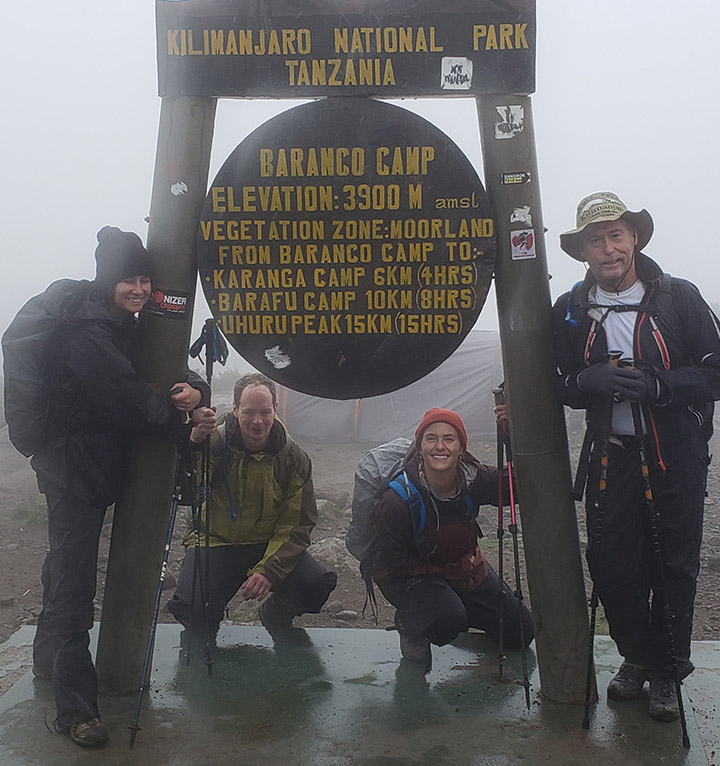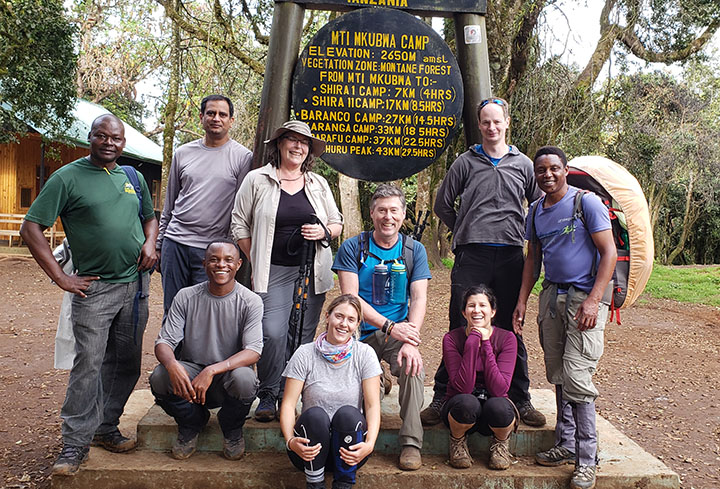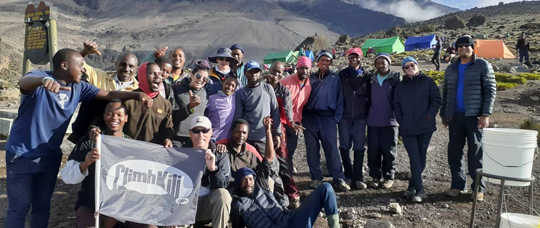by Rick Royce as told to Rick Neilson ’70
As seen in Webb News 2020 edition

Richard A. (Rick) Royce has a Ph.D. in Naval Architecture and Marine Engineering from the University of Michigan and serves as Professor of Naval Architecture at Webb Institute, having been hired in 2001. In addition to his classroom duties, he has performed many different services, including Director of Research; Director of the Robinson Model Basin; leading the Webb “big boat” sailing efforts, including the Newport, R.I. to Bermuda race; and Principal Investigator for the Office of Naval Research (ONR) Navatek Consortium. Under Roger Compton’s leadership, Rick was a major author of the proposal to ONR that secured $2 million in grants for upgrades to the model basin, marine engineering laboratory, and the purchase of a research quality flow channel, in addition to funding research. Rick did a great job managing the resulting funds. In the time I’ve known Rick I have always thought of him as extremely capable and a reasonably sane man. Then I learned that in January of 2020, he planned on climbing Mount Kilimanjaro. Sometimes one has to re-think his opinion of another’s mental stability.
Spending a lot of time in a building the students often refer to as Hogwarts can do strange things to people. Perhaps that is what caused the aberration in the good professor’s mind though he claims this was a long time coming. The real impetus for this adventure came from Rick’s sister, Karen. They have always been close, and Karen wanted to do something special for their upcoming birthdays. So in the summer of 2019 they considered several options, but none seemed quite right. Karen was a geology major and had helped run field camps, as well as having spent extensive time on the Appalachian Trail. She had friends who had taken some African safaris, and she was the one who suggested climbing Mount Kilimanjaro. Rick had done some mountain climbing as far back as college. In the late 1990s he had climbed Mount St. Helens, carrying his skis up and skiing down. Rick’s ex-college roommate worked for Christensen Shipyard in Vancouver, Washington, and when Rick visited him, they would go climbing, including Mt. Adams and Mt. Hood. So Karen’s suggestion didn’t sound crazy. There are a number of companies that arrange a Kilimanjaro climb and after some research, they decided on a company called “Climb Kili.”
Rick knew he had to prepare. He started doing cardio on elliptical trainers in August then threw in some hiking locally, including walking the dog with a full backpack each morning. During Thanksgiving week he went to England, Wales, and Ireland. He did a lot of walking that week and climbed Mt. Knocknarea near Sligo, Ireland, which is only 1,000 feet tall but is steep.
Climb Kili provided an agenda for an eight-day trip that required their arrival on January 10, as well as some instructions. Because the park system limits the weight for porters, each hiker is allowed his or her own personal gear plus a maximum of 15 kg of “extra gear,” which an assigned porter carries. Costs cover transfers to and from Kilimanjaro International Airport, which is located between the cities of Moshi (population approximately 200,000) and Arusha (400,000). Karen and Rick flew from JFK airport and splurged on upgrades to business class, figuring it would be their last chance to be pampered for a while. Upon arrival they were taken to a hotel which was good quality though surrounded by a wall and razor wire.
The group consisted of six climbers, three men and three women. Karen lives in Dublin, Ohio. Besides Rick, the other climbers were from Los Angeles; San Francisco; Edmonton, Alberta; and north of London, England. There were three guides, a cook, a waiter, a dishwasher, a toilet attendant, and 13 porters. Each climber had one porter to carry personal gear such as sleeping pad, sleeping bag, and extra clothes. The remaining porters carried food, tents, and campsite gear.
The actual climb started on January 11 at an altitude of 5,000 feet, where the temperature was between 85 and 90 degrees F. Rick says that as opposed to the mountain climbing one might envision, most of this trek was a slight rise with only a few steep portions. They started at the end of the rainy season although the first day was fine weather. The second day they hiked in the rain. They experienced no other real rain but often climbed in a mist. Each morning they were awakened by the waiter, Balthasar, and his “smooth jazz voice” at 6:30. Then they would pack up their extra gear for porters to carry and prepare their day backpack with two to three liters of water, rain clothes, snacks, trekking poles, hat, gloves, and rain cover for packs. Breakfast would be served around 7:15 and was usually pineapple, porridge, eggs, toast, and diced sausage. While eating, they would have their pulse and oxygen content measured. As long as their O2 level was above 75% they were good to go. If not, there was always the option of staying behind with a guide and catching up later in the day, or having a guide lead the person down the mountain. Guides and porters were always saying “Pole Pole” (poley poley) which means “go slowly.” This allowed porters to pass the climbers on the trail so they could get set up at the next camp, and for those not used to the altitude, the slow pace prevented burn out. The guides and porters were constantly mindful of the physical condition of the climbers and from that point of view they always felt safe. They would leave camp around 8:00. The length of climb varied by day. When they arrived at the next camp, they would have lunch, starting with soup, toast, pineapple, chicken or fish, and potatoes. Then they would unpack their gear and get their tent, air mattress, and sleeping bag situated. Rick would usually walk around quite a bit to make sure he could sleep through the night. Dinner was at 6:30 and consisted of soup, rice, or pasta with stir-fried veggies for topping, potatoes, and fritter type deserts. Rick thought the food was surprisingly good. Hunger may have seasoned it.
Bathroom facilities were less than lavish. The middle-to-high-end tour companies have a toilet attendant. This person carries a portable toilet and tent for the climbers to use. When breaking camp the attendant empties the contents into the bare-bones toilets provided on the mountain. “Bare-bones” means “bare-bones” – think of an outhouse but with no bench seat, just a hole in the floor and the aroma reminiscent of the senior classroom after a ship design all-nighter.

There was one dangerous portion of the climb – a stretch at the Great Baranco Wall. It is an 800-foot rise on a switchback trail with a 60-foot drop-off on one side. Handholds were definitely needed there. Rick did see one person evacuated from the mountain. He was brought down on a gurney of sorts that had only one wheel in its center. It looked extremely uncomfortable but it was the only way available to get someone to one of the mountain’s helipads.
Some highlights of the climb included seeing buffalo tracks at 13,000 feet where there are salt deposits for the buffalo to lick. They stopped at the Moira camp at about 13,300 feet that night although the guides wanted them to go higher where they could get cell phone service. On day seven they started at 16,000 feet around midnight. Rick never considered quitting but the penultimate stretch of the climb to Stella Point at 18,875 feet was quite steep and he felt a bit light-headed. Guides carry oxygen for those climbers who need it, but once they take it, they are required to go back down. After a brief rest, Rick felt fine and the remainder of the trek to the summit at 19, 341 feet involved only a slight rise. They arrived at 6:05 am. It was -10 degrees F. They only stayed 30 minutes at the summit because the sun was coming up and there was a real concern about snow blindness. On the route they took, an average of 70% of the climbers achieve the summit. Not all of the climbers in Rick’s group were able to make it, but all had an experience to remember.
The trip down was a bit anti-climactic. They went by a different route, having climbed the northwest side of the mountain and descending the southwest side. It was certainly quicker than going up, but it was tougher than Rick thought it might be because the descent required the use of different muscles. They left the mountain at 5,000 feet and spent the night in the hotel. Having anticipated the need for a bit of R&R, Karen and Rick flew to Zanzibar for a stay at the Diamonds Mapenzi Beach Resort. This required local currency, so Rick went to get some Tanzanian shillings. The machine he used had a menu asking how many he wanted and not being familiar with the exchange rate, he chose 30,000. Turns out that is equivalent to about $12 US. The exchange fee was $7 US. Next time Webb’s Director of Research will do more research ahead of time.
So what did Rick accomplish on this trip? First, he lost about 10 pounds despite the hi-carb diet. Secondly, he most probably is the first person to drink a Diet Coke at the summit (Rick refused to confirm or deny this with me), and finally, he is not only the first Webb prof to climb Mount Kilimanjaro, he is certainly the first person to unfurl a Webb banner on the summit. Congratulations are in order. I can’t wait to hear what he does next winter. If he invites me, I’m busy that day.

Photo Credit: Climb Kili

